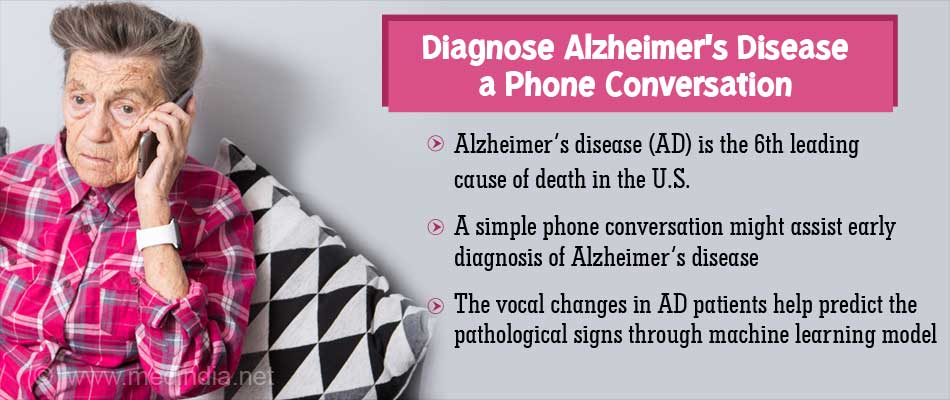, the range of symptoms along with co-existing symptoms diversifies between different patients. The key note is that patients remain
Thus along with other factors like cost-effectiveness, manual interpretations, and increased diagnostic difficulties rendered by Alzheimer’s disease, there is a need for a simple tool that may help assess this chronic disease.
Vocal Features as a Diagnostic Tool
Identifying AD at an earlier stage may further ease the burden of the disease among both patients and caregivers and initiate the right treatment. One of the key features of patients with AD is their slow speech rate with long pauses and difficulty finding correct words. These may show a lack of speech fluency due to broken messages.
There are several machine-learning algorithms (models) recently that have demonstrated greater accuracy and efficiency in predicting the early onset of AD.
However, the effectiveness of these tools tends to differ. Thus to redefine the existing models, the present team developed a new and improved machine learning model using vocal features that assist in identifying early signs of Alzheimer’s disease.
The Novel Machine Learning Model
The study team developed an accurate predictive model using 1,465 audio data files from 99 healthy participants and 151 audio data files recorded from 24 AD patients, which arose from a dementia prevention program in Hachioji City in Tokyo.
The telephone conversations were recorded from age groups of 65 years or older between March and May of 2020. The audio data were then utilized to generate machine learning models based on techniques like extreme gradient boosting (XGBoost), random forest (RF), and logistic regression (LR).
The Outcome of the Vocal Model
The effectiveness, sensitivity, and specificity of the predictive performance of the models were further validated and compared to multiple machine learning algorithms with conventional cognitive tests.
It was seen that the present model had a predictive performance and accuracy similar to other diagnostic tests with no significant difference.
Certain limitations like the use of only binary samples (either healthy or AD), limited range of clinical diagnoses, reduced sample size, audio quality, and superficial vocal features may result in limited information. This may in turn lead to misidentification of the diagnosis.
However, the present model serves as a promising potential for assessing the risk of Alzheimer’s disease in healthy vs cognitively impaired individuals. Further data is mandated to expand the concept for more reliable diagnosis and benefit of the affected patients.
Facts on Alzheimer’s disease
- Alzheimer’s disease adds to 60-70% of all the dementia cases.
- AD is the prime cause of disability and dependency among older people worldwide.
-
Alzheimer’s disease is reported to be the 6th foremost cause of death in the U.S. -
The mortality rate of AD has risen by 145% between 2000 and 2019. -
An estimated 44 million people are living with Alzheimer’s disease or a related form of dementia worldwide. -
America includes 6.2 million AD patients above 65 years of age in 2021 and may reach 12.7 million by 2050. -
Eighty percent of AD patients are of age 75 years or older and two-thirds are women. - One in 9 people age 65 and older (11.3%) have Alzheimer’s dementia.
-
The life expectancy of an AD patient may be between 4-8 years after diagnosis. -
The total cost of AD and other dementia estimates at around $259 billion in the U.S. and may reach $1.1 trillion by 2050.
Preventive Measures for Alzheimer’s disease
- Although the disease has no significant cure from conventional treatment, certain measures may help delay the onset as well as prevent the worsening of the pathological course
- Engage in regular physical exercise as a healthy body also frames to healthy mind and brain.
- Have a healthy balanced diet for well-being.
- Commit yourself to learn and engage in cognitive activities like healthy thinking and social communication to promote brain strength.
- Practice mind exercise like yoga and group laughing therapy
- Note for any behavioral and psychological changes in routine activities
- Consult your specialist at an early stage to prevent worsening of the disease
- Render proper information and long-term support to elderly-affected individuals.
References:
- Dementia risks identified by vocal features via telephone conversations: A novel machine learning prediction model
– (https://journals.plos.org/plosone/article?id=10.1371/journal.pone.0253988) - A Method for Analysis of Patient Speech in Dialogue for Dementia Detection
– (https://arxiv.org/abs/1811.09919) - Dementia – (https://www.who.int/news-room/fact-sheets/detail/dementia)
Source: Medindia



